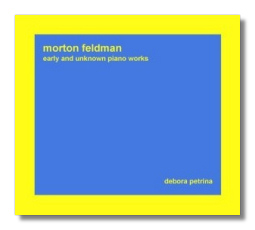
The Internet's Premier Classical Music Source
Related Links
- Feldman Reviews
- Latest Reviews
- More Reviews
-
By Composer
-
Collections
DVD & Blu-ray
Books
Concert Reviews
Articles/Interviews
Software
Audio
Search Amazon
Recommended Links
Site News
 CD Review
CD Review
Morton Feldman

Early & Unknown Piano Works
- First Piano Sonata
- Preludio
- Self Portrait
- Three Dances
- For Cynthia
- Two Pieces for Three Pianos
Debora Petrina, piano
OgreOgress (UPC 643157237426) 54:54
This is a collection of Morton Feldman's "Early and Unknown Piano Works," although it might better have been named "Early or Unknown Piano Works" – the Two Pieces for Three Pianos (which occupy well over half the length of this CD) date from 1966 when the composer was 40. Feldman's mature style can be heard in this pair of works. Surprisingly, Two Pieces for Three Pianos has not been recorded before.
But let's not quibble. This is a self-recommending CD for anyone who wants to trace the trajectory of Feldman's development as a composer for piano. The terse First Piano Sonata (dedicated to Béla Bartók) was written when the composer was 17. It doesn't sound much like Feldman, nor does it sound much like Bartók, who nevertheless was more of a musical influence on the young composer than Wallingford Riegger, who was his teacher at the time.
Preludio and Self Portrait date from 1944-45, when Feldman had left Riegger's tutelage and was studying with Stefan Wolpe. Feldman found Wolpe's teaching hardly more helpful than Riegger's, and these two works inhabit a stylistic netherworld similar to the First Sonata's, although their shorter lengths are a sort of corset, if you will, that keeps them from spreading.
With Three Dances, we come both to a title and to music that suggests John Cage, with whom Feldman became acquainted circa 1950. Feldman's Three Dances, while thirteen short of Cage's Sixteen Dances (composed at almost exactly the same time) do inhabit similar territory. The last of the three asks the pianist to strike a drum, a glass, and the same left-hand chord repeatedly, and the effect is not dissimilar to that of Cage's Four Walls, a work composed in 1944.
Composed sometime in the 1950s, For Cynthia (an allusion to Feldman's wife at the time?) is a 41-second riddle – a piano exercise married to a nursery rhyme, perhaps. No doubt the Sphinx smiles to hear it played.
With the aforementioned Two Pieces for Three Pianos, we've reached a watershed. Here, the mature Feldman revels in megalithic block chords, their decay, and silence. Like some of the best of Feldman's work, it's the musical equivalent of a trip to Stonehenge. Petrina performs these imposing studies in attack and decay as a solo, thanks to OgreOgress's guiding spirit Glenn Freeman, and multi-track recording technologies.
Petrina negotiates these difficult territories like a surefooted mountain goat. Her performances are attractive but not prettified or tainted with Romanticism.
The minimalist packaging is both fascinating and frustrating. A plastic nipple holds the CD to the inside of a folded card stock "jacket"; the booklet notes are printed (somewhat illegibly) on the inside of the jacket. If you want specific track numbers and timings, they are printed only on the CD itself, and once you get the CD in the player, it's too late!
OgreOgress discs can be purchased through their website, ogreogress.home-page.org. Given the unique repertoire included here, this CD is a must for anyone who cares about Feldman.
Copyright © 2004, Raymond Tuttle




















